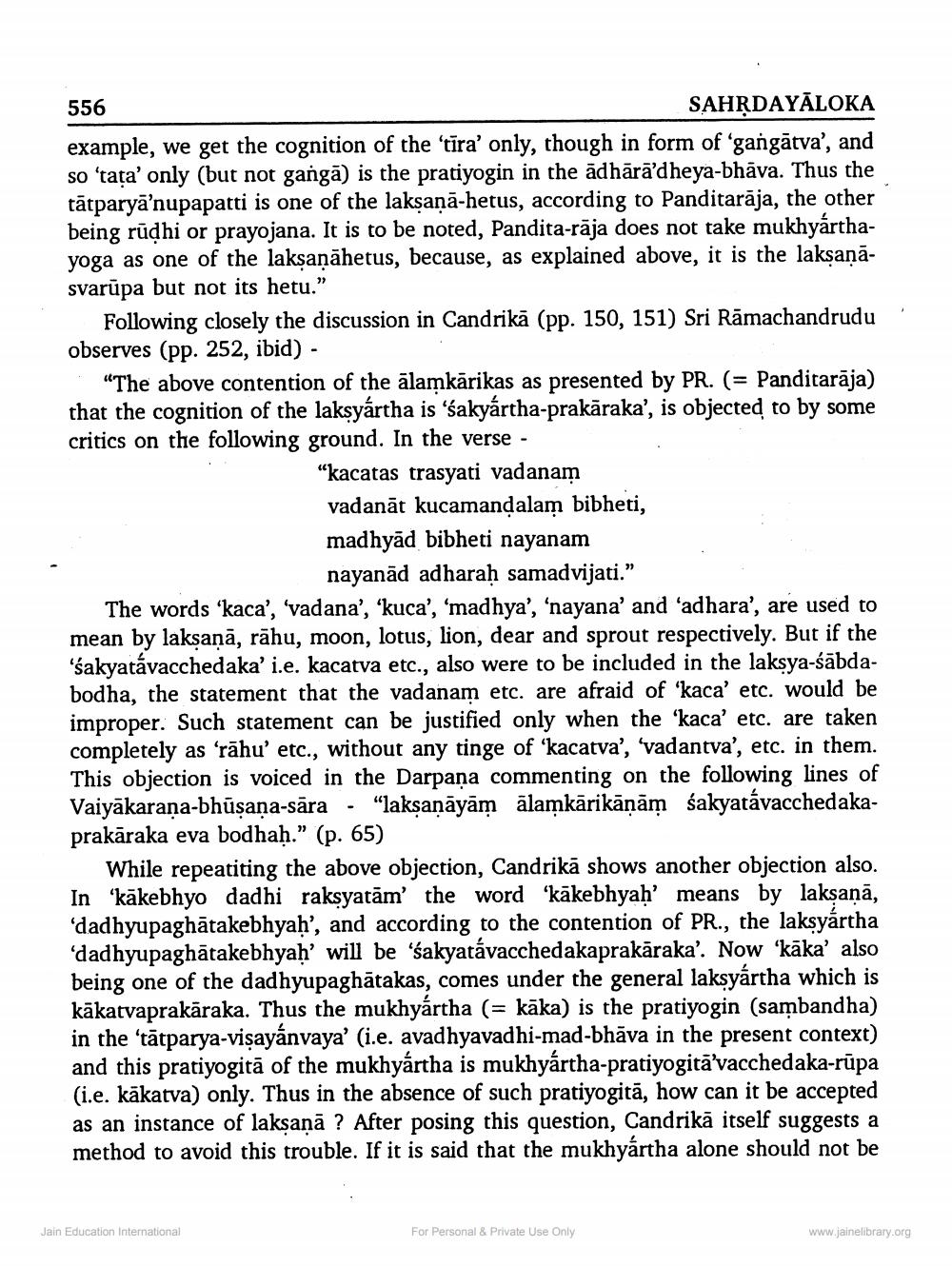________________
556
SAHRDAYĀLOKA example, we get the cognition of the 'tīra' only, though in form of gangātva', and so 'tata' only (but not gangā) is the pratiyogin in the adhārā’dheya-bhāva. Thus the tātparyā'nupapatti is one of the laksaņā-hetus, according to Panditarāja, the other being rūļhi or prayojana. It is to be noted, Pandita-rāja does not take mukhyárthayoga as one of the laksanāhetus, because, as explained above, it is the laksanāsvarūpa but not its hetu.”
Following closely the discussion in Candrikā (pp. 150, 151) Sri Rāmachandrudu observes (pp. 252, ibid) *. "The above contention of the ālamkārikas as presented by PR. (= Panditarāja) that the cognition of the laksyártha is 'śakyártha-prakāraka', is objected to by some critics on the following ground. In the verse -
“kacatas trasyati vadanam
vadanāt kucamandalam bibheti, madhyād bibheti nayanam
nayanād adharaḥ samadvijati.” The words 'kaca', 'vadana', 'kuca', 'madhya', 'nayana' and 'adhara', are used to mean by laksaņā, rāhu, moon, lotus, lion, dear and sprout respectively. But if the 'sakyatávacchedaka' i.e. kacatva etc., also were to be included in the laksya-śābdabodha, the statement that the vadanam etc. are afraid of ‘kaca' etc. would be improper. Such statement can be justified only when the ‘kaca' etc. are taken completely as ‘rāhu' etc., without any tinge of 'kacatva', 'vadantva', etc. in them. This objection is voiced in the Darpana commenting on the following lines of Vaiyākarana-bhūsana-sāra - "laksanāyām ālamkārikāņām śakyatávacchedakaprakāraka eva bodhah.” (p. 65)
While repeatiting the above objection, Candrikā shows another objection also. In 'kākebhyo dadhi raksyatām' the word 'kākebhyah' means by laksaņā, 'dadhyupaghātakebhyaḥ, and according to the contention of PR., the laksyártha 'dadhyupaghātakebhyah' will be 'sakyatávacchedakaprakāraka'. Now ‘kāka’ also being one of the dadhyupaghātakas, comes under the general laksyártha which is kākatvaprakāraka. Thus the mukhyártha (= kāka) is the pratiyogin (sambandha) in the 'tātparya-visayánvaya' (i.e. avadhyavadhi-mad-bhāva in the present context) and this pratiyogitā of the mukhyártha is mukhyártha-pratiyogitā’vacchedaka-rūpa (i.e. kākatva) only. Thus in the absence of such pratiyogitā, how can it be accepted as an instance of laksaņā ? After posing this question, Candrikā itself suggests a method to avoid this trouble. If it is said that the mukhyārtha alone should not be
Jain Education International
For Personal & Private Use Only
www.jainelibrary.org




